Abstract
The pooled degenerate-primer polymerase chain reaction (PCR) technology is now widely used in the amplification and cloning of murine hybridoma-specific immunoglobulin gene cDNAs. The design of primers is mainly based on the highly conserved 5' terminus of immunoglobulin gene variable regions and the constant region in the 3' terminus. Of note, most murine hybridoma cell lines are derived from the Sp2/0 cell line, which is demonstrated to express endogenous aberrant kappa chains (abV kappa). This high-level endogenous abV kappa mixes with specific kappa chains in the hybridomas and interferes with the efficiency of the reverse transcriptase (RT)-PCR cloning strategy. In this report, during the cloning of murine anti-human immunodeficiency virus type I (HIV-1) hybridoma immunoglobulin cDNAs, a specific primer-PCR screening system was developed, based on the abV kappa complementarity-defining region (CDR), to eliminate abV kappa-carrying plasmids. Furthermore, an abV kappa sequence-specific derived ribozyme was developed and packaged in a retroviral expression vector system. This abV kappa ribozyme can be transduced into different murine hybridomas, and expressed intracellularly to potently eliminate endogenous abV kappa RNA.
Full text
PDF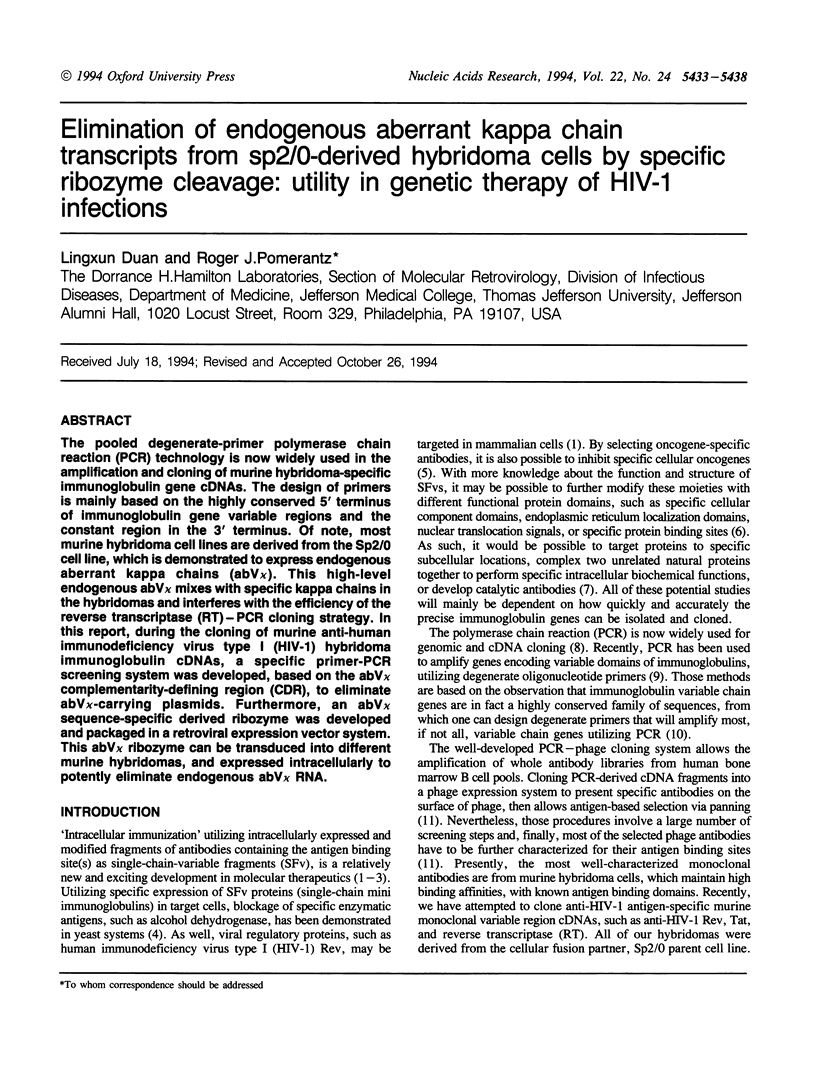
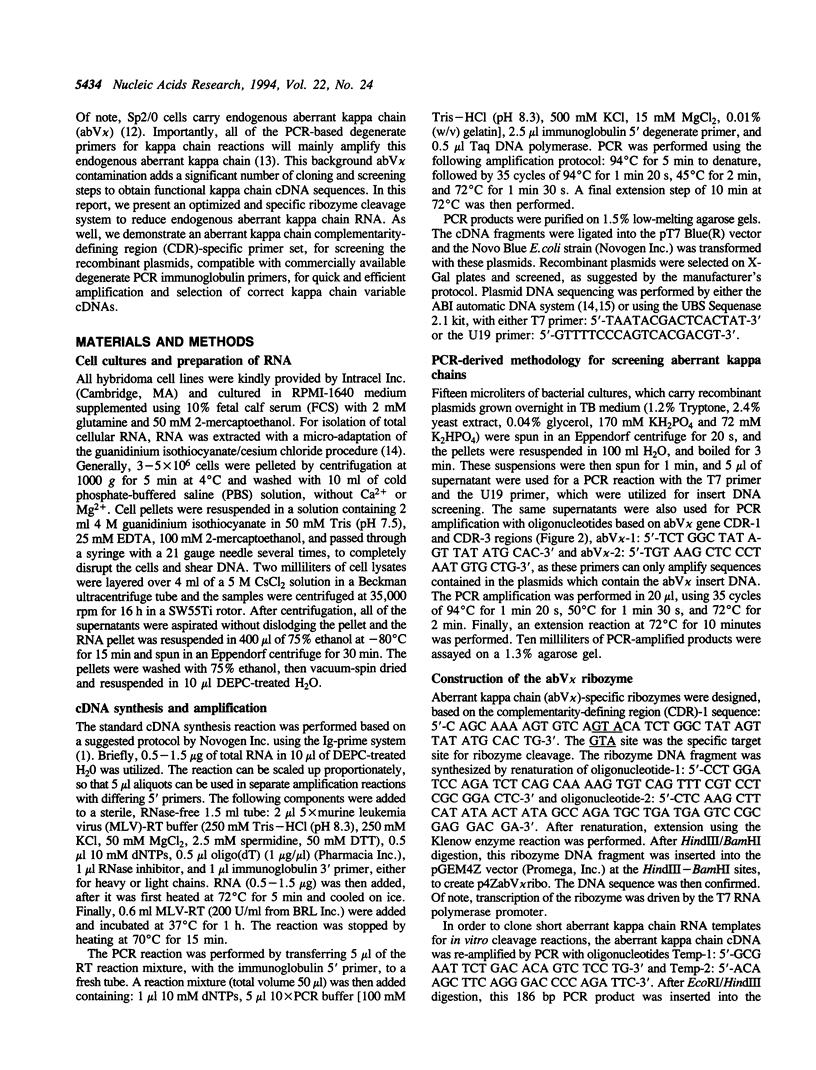
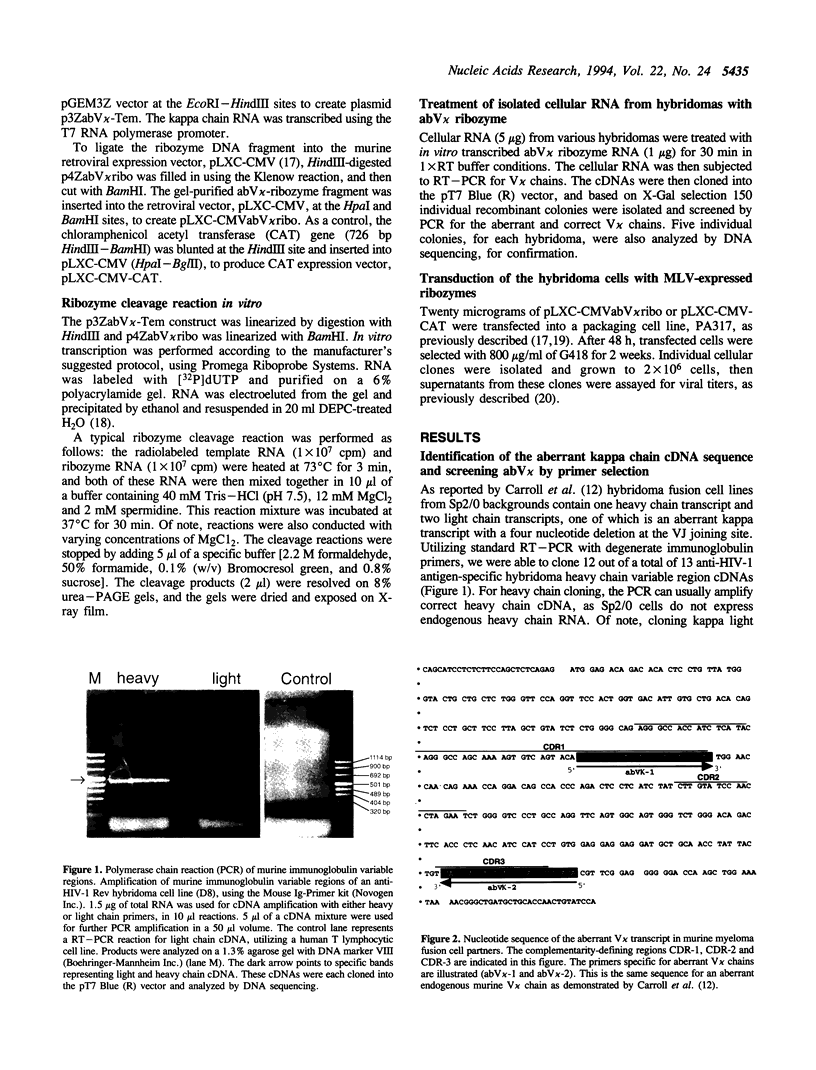
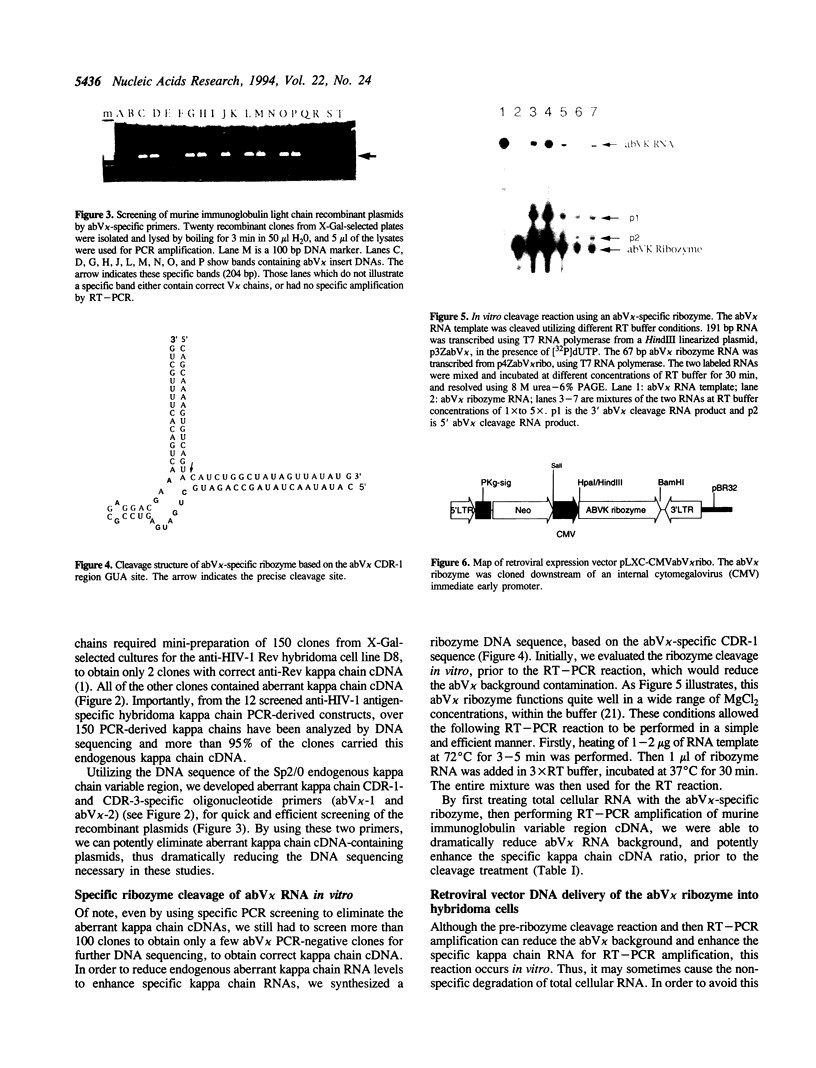
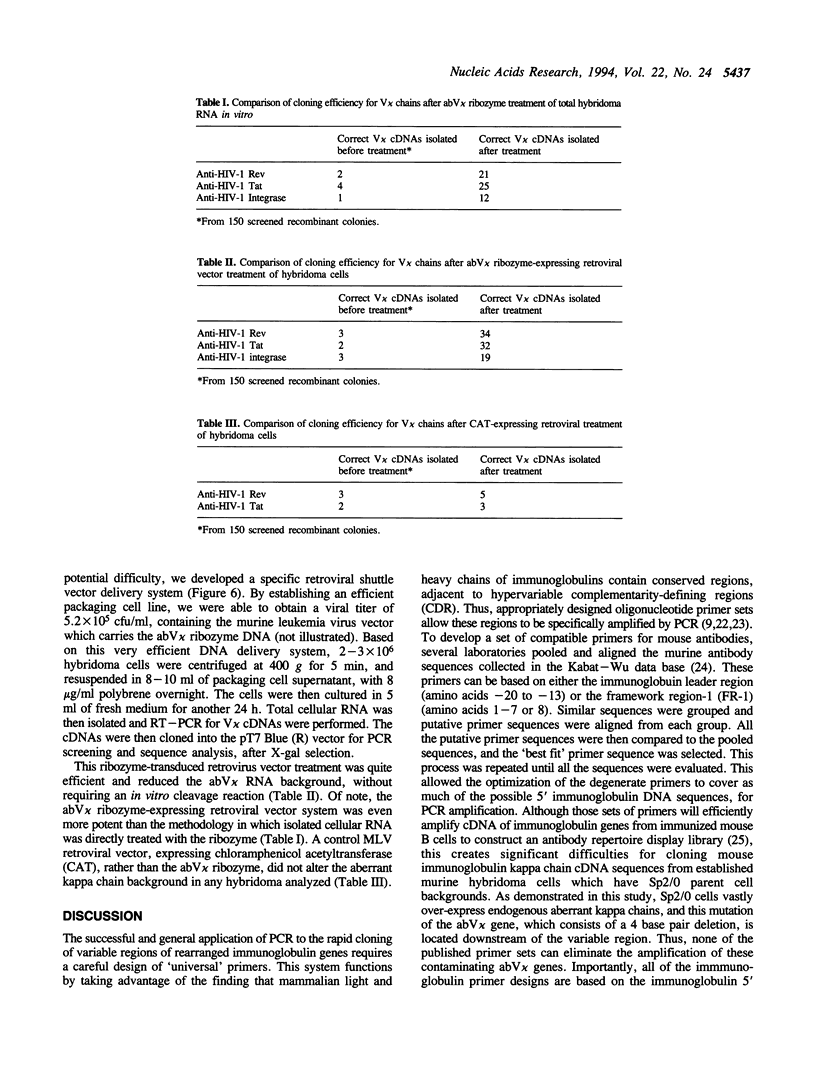
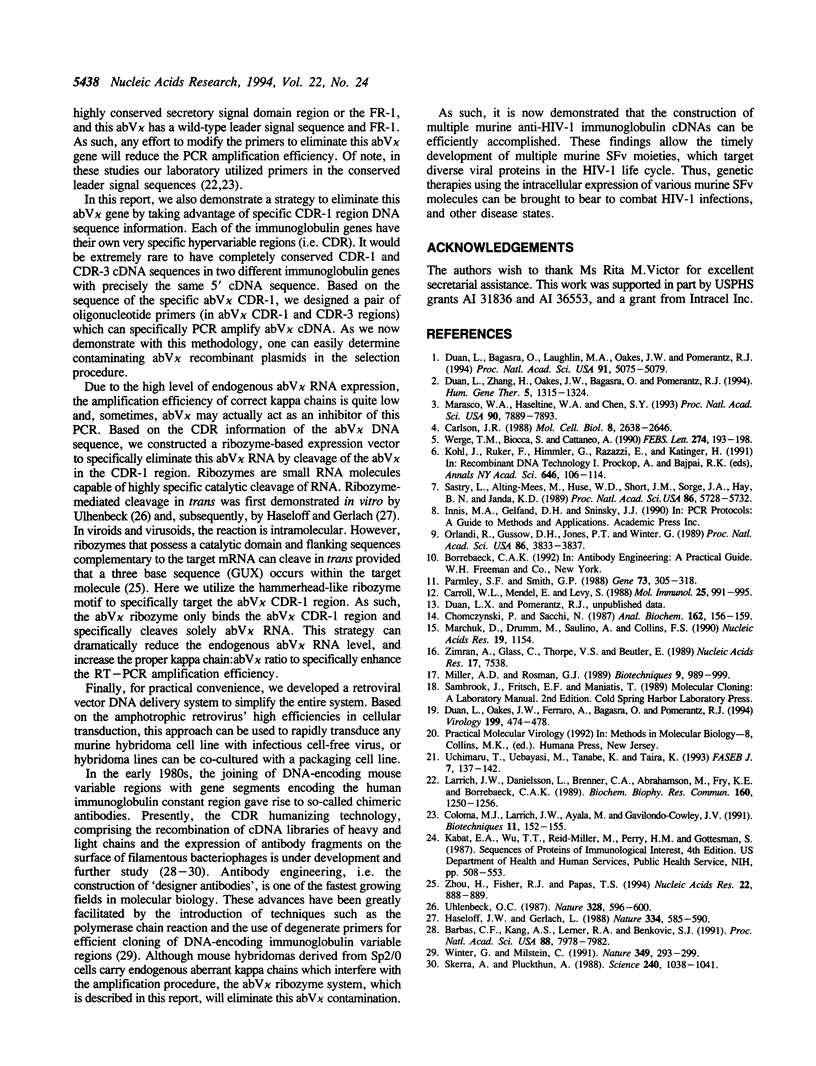
Images in this article
Selected References
These references are in PubMed. This may not be the complete list of references from this article.
- Barbas C. F., 3rd, Kang A. S., Lerner R. A., Benkovic S. J. Assembly of combinatorial antibody libraries on phage surfaces: the gene III site. Proc Natl Acad Sci U S A. 1991 Sep 15;88(18):7978–7982. doi: 10.1073/pnas.88.18.7978. [DOI] [PMC free article] [PubMed] [Google Scholar]
- Carlson J. R. A new means of inducibly inactivating a cellular protein. Mol Cell Biol. 1988 Jun;8(6):2638–2646. doi: 10.1128/mcb.8.6.2638. [DOI] [PMC free article] [PubMed] [Google Scholar]
- Carroll W. L., Mendel E., Levy S. Hybridoma fusion cell lines contain an aberrant kappa transcript. Mol Immunol. 1988 Oct;25(10):991–995. doi: 10.1016/0161-5890(88)90005-3. [DOI] [PubMed] [Google Scholar]
- Chomczynski P., Sacchi N. Single-step method of RNA isolation by acid guanidinium thiocyanate-phenol-chloroform extraction. Anal Biochem. 1987 Apr;162(1):156–159. doi: 10.1006/abio.1987.9999. [DOI] [PubMed] [Google Scholar]
- Coloma M. J., Larrick J. W., Ayala M., Gavilondo-Cowley J. V. Primer design for the cloning of immunoglobulin heavy-chain leader-variable regions from mouse hybridoma cells using the PCR. Biotechniques. 1991 Aug;11(2):152-4, 156. [PubMed] [Google Scholar]
- Duan L., Bagasra O., Laughlin M. A., Oakes J. W., Pomerantz R. J. Potent inhibition of human immunodeficiency virus type 1 replication by an intracellular anti-Rev single-chain antibody. Proc Natl Acad Sci U S A. 1994 May 24;91(11):5075–5079. doi: 10.1073/pnas.91.11.5075. [DOI] [PMC free article] [PubMed] [Google Scholar] [Retracted]
- Duan L., Oakes J. W., Ferraro A., Bagasra O., Pomerantz R. J. Tat and rev differentially affect restricted replication of human immunodeficiency virus type 1 in various cells. Virology. 1994 Mar;199(2):474–478. doi: 10.1006/viro.1994.1148. [DOI] [PubMed] [Google Scholar]
- Duan L., Zhang H., Oakes J. W., Bagasra O., Pomerantz R. J. Molecular and virological effects of intracellular anti-Rev single-chain variable fragments on the expression of various human immunodeficiency virus-1 strains. Hum Gene Ther. 1994 Nov;5(11):1315–1324. doi: 10.1089/hum.1994.5.11-1315. [DOI] [PubMed] [Google Scholar]
- Haseloff J., Gerlach W. L. Simple RNA enzymes with new and highly specific endoribonuclease activities. Nature. 1988 Aug 18;334(6183):585–591. doi: 10.1038/334585a0. [DOI] [PubMed] [Google Scholar]
- Larrick J. W., Danielsson L., Brenner C. A., Abrahamson M., Fry K. E., Borrebaeck C. A. Rapid cloning of rearranged immunoglobulin genes from human hybridoma cells using mixed primers and the polymerase chain reaction. Biochem Biophys Res Commun. 1989 May 15;160(3):1250–1256. doi: 10.1016/s0006-291x(89)80138-x. [DOI] [PubMed] [Google Scholar]
- Marasco W. A., Haseltine W. A., Chen S. Y. Design, intracellular expression, and activity of a human anti-human immunodeficiency virus type 1 gp120 single-chain antibody. Proc Natl Acad Sci U S A. 1993 Aug 15;90(16):7889–7893. doi: 10.1073/pnas.90.16.7889. [DOI] [PMC free article] [PubMed] [Google Scholar]
- Marchuk D., Drumm M., Saulino A., Collins F. S. Construction of T-vectors, a rapid and general system for direct cloning of unmodified PCR products. Nucleic Acids Res. 1991 Mar 11;19(5):1154–1154. doi: 10.1093/nar/19.5.1154. [DOI] [PMC free article] [PubMed] [Google Scholar]
- Orlandi R., Güssow D. H., Jones P. T., Winter G. Cloning immunoglobulin variable domains for expression by the polymerase chain reaction. Proc Natl Acad Sci U S A. 1989 May;86(10):3833–3837. doi: 10.1073/pnas.86.10.3833. [DOI] [PMC free article] [PubMed] [Google Scholar]
- Parmley S. F., Smith G. P. Antibody-selectable filamentous fd phage vectors: affinity purification of target genes. Gene. 1988 Dec 20;73(2):305–318. doi: 10.1016/0378-1119(88)90495-7. [DOI] [PubMed] [Google Scholar]
- Sastry L., Alting-Mees M., Huse W. D., Short J. M., Sorge J. A., Hay B. N., Janda K. D., Benkovic S. J., Lerner R. A. Cloning of the immunological repertoire in Escherichia coli for generation of monoclonal catalytic antibodies: construction of a heavy chain variable region-specific cDNA library. Proc Natl Acad Sci U S A. 1989 Aug;86(15):5728–5732. doi: 10.1073/pnas.86.15.5728. [DOI] [PMC free article] [PubMed] [Google Scholar]
- Skerra A., Plückthun A. Assembly of a functional immunoglobulin Fv fragment in Escherichia coli. Science. 1988 May 20;240(4855):1038–1041. doi: 10.1126/science.3285470. [DOI] [PubMed] [Google Scholar]
- Uchimaru T., Uebayasi M., Tanabe K., Taira K. Theoretical analyses on the role of Mg2+ ions in ribozyme reactions. FASEB J. 1993 Jan;7(1):137–142. doi: 10.1096/fasebj.7.1.8422960. [DOI] [PubMed] [Google Scholar]
- Uhlenbeck O. C. A small catalytic oligoribonucleotide. Nature. 1987 Aug 13;328(6131):596–600. doi: 10.1038/328596a0. [DOI] [PubMed] [Google Scholar]
- Werge T. M., Biocca S., Cattaneo A. Intracellular immunization. Cloning and intracellular expression of a monoclonal antibody to the p21ras protein. FEBS Lett. 1990 Nov 12;274(1-2):193–198. doi: 10.1016/0014-5793(90)81362-r. [DOI] [PubMed] [Google Scholar]
- Winter G., Milstein C. Man-made antibodies. Nature. 1991 Jan 24;349(6307):293–299. doi: 10.1038/349293a0. [DOI] [PubMed] [Google Scholar]
- Zhou H., Fisher R. J., Papas T. S. Optimization of primer sequences for mouse scFv repertoire display library construction. Nucleic Acids Res. 1994 Mar 11;22(5):888–889. doi: 10.1093/nar/22.5.888. [DOI] [PMC free article] [PubMed] [Google Scholar]
- Zimran A., Glass C., Thorpe V. S., Beutler E. Analysis of 'color PCR' by automatic DNA sequencer. Nucleic Acids Res. 1989 Sep 25;17(18):7538–7538. doi: 10.1093/nar/17.18.7538. [DOI] [PMC free article] [PubMed] [Google Scholar]





